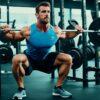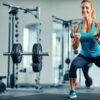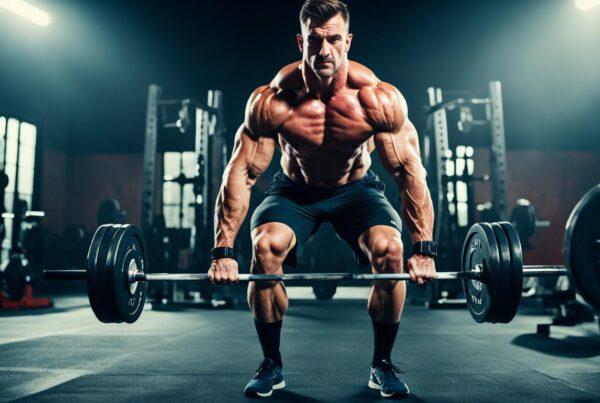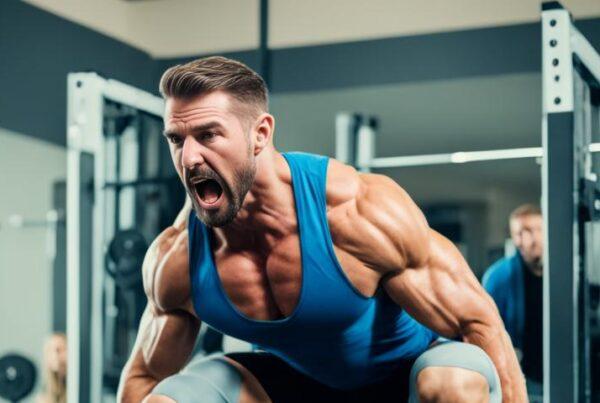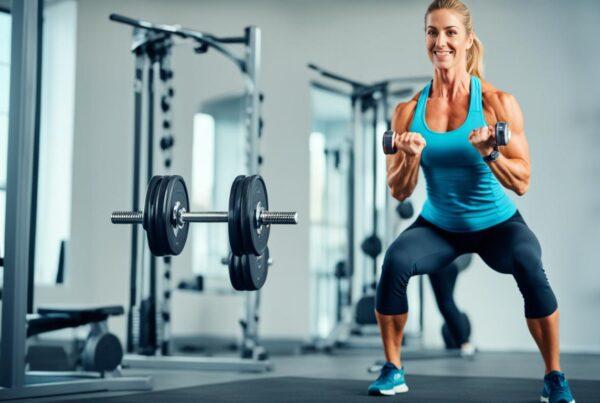When you don’t have access to gym equipment, you can still strengthen your core with no-equipment ab exercises. These exercises can be done at home and require only your bodyweight. They include plank variations, leg raises, and crunches. Building a strong core is important not just for aesthetics but also for maintaining balance, good posture, and overall strength in your body. By engaging your core muscles regularly, you can improve your stability and perform better in various fitness activities.
Key Takeaways:
- No-equipment ab exercises can be done at home and require only your bodyweight.
- Plank variations, leg raises, and crunches are effective exercises for strengthening your core.
- Building a strong core improves balance, posture, and overall strength in your body.
- Regularly engaging your core muscles can enhance stability and performance in fitness activities.
- By incorporating these exercises into your routine, you can develop a strong and sculpted core.
Core Workout You Can Do at Home
Get ready to strengthen your core with this no-equipment workout that targets your abs, obliques, and deep core muscles. With just a few exercises, you can work towards a strong and defined midsection from the comfort of your own home.
During this workout, perform each exercise for one minute, followed by a 30-second rest period. As you progress, feel free to increase the intensity by swapping the rest period with jogging in place. For a more challenging session, repeat the entire workout for a total of 30 minutes.
Here are the exercises you’ll be doing:
- Plank to Dolphin: Start in a forearm plank position and then push your hips up into a downward dog position. Alternate between the two.
- Push-Up: Begin in a high plank position, lower your body towards the floor, and then push back up.
- Plank Tap: From a high plank position, tap your hand to the opposite shoulder, alternating sides.
- Forearm Side Plank with Twist: Start in a forearm side plank and then rotate your top arm towards the ceiling, twisting your torso.
- Bicycle Crunch: Lie on your back, bend your knees, and perform a bicycle motion with your legs while simultaneously twisting your upper body.
- Plank to Downward Dog: Similar to the plank to dolphin exercise, but this time transition from a high plank to a downward dog.
- Diamond Push-Up: Place your hands close together so that your thumbs and index fingers form a diamond shape. Perform a push-up in this position.
- Lateral Plank Walk: Start in a high plank position and then step your hand and foot out to the side, alternating sides.
- Boat Pose: Sit on the floor, lift your legs, and balance on your sit bones while reaching your arms forward.
Remember to focus on proper form and engage your core muscles throughout each exercise. Take breaks when needed, but push yourself to complete the full minute for each exercise. With consistency and dedication, you’ll start seeing improvements in your core strength and definition.
Now, let’s get started on this challenging core workout that will leave your abs burning and your body stronger than ever!
| Exercise | Duration |
|---|---|
| Plank to Dolphin | 1 minute |
| Push-Up | 1 minute |
| Plank Tap | 1 minute |
| Forearm Side Plank with Twist | 1 minute |
| Bicycle Crunch | 1 minute |
| Plank to Downward Dog | 1 minute |
| Diamond Push-Up | 1 minute |
| Lateral Plank Walk | 1 minute |
| Boat Pose | 1 minute |
No-Equipment Ab Exercises you can do at Home.
If you prefer to create your own ab workout, you have the freedom to choose from a list of twelve popular no-equipment ab exercises. Some of these exercises include standard crunches, jackknives, star crunches, reverse crunches, crab toe touches, mountain climbers, leg lift extensions, Russian twists, side plank hip dips, heel taps, floor wipers, and bicycles. Select at least 4-5 exercises that target different areas of your stomach to create a complete ab workout. You can structure your workout based on time, number of reps and rounds, or using a timer. Rest between exercises or rounds according to your preference and fitness level.
For example, you could start with a set of standard crunches to target your upper abs, followed by some jackknives to engage your lower abs. Then, incorporate star crunches to work on your obliques, and continue with reverse crunches to activate your entire core. To add an element of cardio, include mountain climbers for a high-intensity burn.
Remember, the key is to choose exercises that challenge your core muscles and keep you engaged. Don’t be afraid to mix and match different exercises to create a workout that suits your needs and preferences.
If you’re looking to add some variety, try exercises like crab toe touches, leg lift extensions, Russian twists, side plank hip dips, heel taps, floor wipers, and bicycles. These exercises target different areas of your abs and introduce new movements that can help keep your workouts exciting and effective.
When structuring your workout, you can either perform each exercise for a set amount of time, such as 30 seconds to 1 minute, or choose a specific number of repetitions for each exercise. Alternatively, you can set a timer and perform as many rounds as possible within a certain timeframe, such as 10 or 15 minutes.
Remember to listen to your body and rest as needed between exercises or rounds. If you’re just starting out, you may want to begin with shorter intervals and gradually increase the duration or intensity as you build strength and endurance.
Sample No-Equipment Ab Workout:
Here’s an example of a no-equipment ab workout you can try:
| Exercise | Reps/Time |
|---|---|
| Standard Crunches | 15 reps |
| Jackknives | 12 reps |
| Star Crunches | 10 reps/side |
| Reverse Crunches | 15 reps |
| Mountain Climbers | 30 seconds |
Perform each exercise with proper form and control, focusing on engaging your core muscles throughout. Take a 30-second rest between exercises and repeat the circuit for 2-3 rounds, depending on your fitness level.
 Remember, the key to a successful ab workout is consistency. Aim to incorporate these exercises into your routine at least 2-3 times per week for optimal results. With dedication and effort, you’ll be on your way to a stronger and more defined core.
Remember, the key to a successful ab workout is consistency. Aim to incorporate these exercises into your routine at least 2-3 times per week for optimal results. With dedication and effort, you’ll be on your way to a stronger and more defined core.
Benefits of a Strong Core
Developing a strong core offers numerous benefits for your overall health and fitness. A strong core can improve your posture by maintaining proper alignment of the spine, reducing the risk of back pain and muscle imbalances.
Having a strong core also enhances stability and balance, making you more efficient in various physical activities. Whether you’re running, playing sports, or simply going about your daily tasks, a strong core provides the enhanced stability and balance you need to move with confidence and control.
In addition, a strong core contributes to a reduced risk of injury. By improving body mechanics and providing better support to vulnerable joints, a strong core helps prevent common injuries such as strains, sprains, and even falls.
Another advantage of a strong core is improved athletic performance. A strong core enables better force transfer, allowing you to generate more power and move more efficiently. It also increases agility, helping you perform quick movements and change direction with ease.
Beyond physical performance, having a strong core improves functional strength. Functional strength refers to the ability to carry out everyday activities with ease and without pain or strain. By strengthening your core muscles, you enhance your ability to perform movements required in daily life, such as lifting, twisting, and bending.
Moreover, a strong core is crucial for enhanced back health. It helps to support the spine, reducing the risk of lower back pain. By strengthening the muscles that surround the spine, a strong core provides a solid foundation for everyday movements and helps protect the back from injury.
Another advantage of a strong core is improved breathing and organ support. The core musculature, including the diaphragm and pelvic floor muscles, plays a significant role in breathing and supporting the organs. A strong core helps promote better breath control and supports the optimal functioning of organs in the abdominal region.
Last but not least, a strong core can contribute to streamlined aesthetics. Engaging in regular core-strengthening exercises can help tone and sculpt your midsection, resulting in a leaner and more defined appearance.
| Benefits of a Strong Core |
|---|
| Improved posture |
| Enhanced stability and balance |
| Reduced risk of injury |
| Improved athletic performance |
| Functional strength |
| Enhanced back health |
| Improved breathing and organ support |
| Streamlined aesthetics |
Core Muscles and Their Functions
The core muscles play a crucial role in providing stability, support, and movement for your spine and pelvis. Understanding the functions of these muscles can help you develop a comprehensive core workout routine that targets each muscle group effectively.
- Rectus Abdominis: This muscle flexes the spine and stabilizes the trunk. It’s commonly known as the “six-pack” muscle and is responsible for the forward bending of the spine.
- Transverse Abdominis: The transverse abdominis is located deep within the abdomen and acts as a natural corset, providing core stability. It plays a vital role in maintaining good posture and protecting the spine during movement.
- Obliques: The oblique muscles consist of the external obliques and internal obliques. They assist in trunk rotation and side bending, allowing for twisting and turning movements.
- Multifidus: The multifidus muscle spans the length of the spine and helps stabilize individual vertebrae. It plays a crucial role in maintaining proper spinal alignment and preventing excessive movement or strain on the vertebrae.
- Erector Spinae: The erector spinae muscles are located on either side of the spine and extend and rotate the back. They provide support and stability to the spine, especially during activities that involve bending or lifting.
- Diaphragm: The diaphragm is a dome-shaped muscle that assists in breathing and contributes to core stability. It contracts and expands to facilitate inhalation and exhalation while also helping to support the organs in the abdominal cavity.
- Pelvic Floor Muscles: The pelvic floor muscles are a group of muscles located at the base of the pelvis. They support the pelvic organs and contribute to core stability. Strengthening these muscles is especially important for women both during and after pregnancy.
- Hip Muscles: The hip muscles, including the hip flexors and abductors, play a significant role in stabilizing the pelvis and allowing for efficient movement. Strong hip muscles contribute to improved balance and overall core strength.
By targeting these core muscles in your workouts, you can improve your core strength, stability, and overall physical performance.
Stay tuned for the next section where we’ll discuss two effective core exercises: the Dead Bug exercise and the Lying Leg Raise!
The Dead Bug Exercise and Lying Leg Raise
When it comes to strengthening your core, two exercises that often come to mind are the Dead Bug exercise and the Lying Leg Raise. These exercises target specific muscles in your abdomen and can be incorporated into your core workout routine to enhance your overall core strength and stability.
The Dead Bug Exercise
The Dead Bug exercise is a popular core-strengthening exercise that primarily targets the transverse abdominis, one of the deep abdominal muscles. This exercise is performed by lying on your back with your arms and legs extended towards the ceiling. From this position, you slowly lower one arm and the opposite leg towards the ground while keeping your lower back pressed against the floor. Alternate sides and repeat for the desired number of reps.
The Dead Bug exercise helps improve core stability, coordination, and control. By engaging the transverse abdominis, it helps to create a strong and supportive core, which is essential for maintaining proper posture and reducing the risk of back pain.
Lying Leg Raise
The Lying Leg Raise is another effective exercise for targeting the muscles of the lower abdomen and hip flexors. To perform this exercise, lie on your back with your legs straight and your arms resting by your sides. Slowly lift both legs off the ground while keeping your lower back pressed against the floor. Lower your legs back down with control and repeat for the desired number of reps.
The Lying Leg Raise is a great exercise for strengthening the rectus abdominis, the muscle responsible for the six-pack appearance, as well as the hip flexors. By regularly incorporating this exercise into your core routine, you can improve the strength and definition of your abdominal muscles.
| Exercise | Target Muscles |
|---|---|
| Dead Bug exercise | Transverse Abdominis |
| Lying Leg Raise | Rectus Abdominis, Hip Flexors |
Both the Dead Bug exercise and the Lying Leg Raise are effective in strengthening the core muscles and can be modified to suit different fitness levels. They can be incorporated into your core workout routine or performed as standalone exercises. Remember to maintain proper form, engage your core muscles, and breathe deeply throughout each exercise for optimal results.
Now that you have learned about the Dead Bug exercise and the Lying Leg Raise, consider adding them to your core workout routine. Strengthening your core will not only improve your overall stability and balance but also contribute to better posture and reduced risk of injury. Start incorporating these exercises today and enjoy the benefits of a stronger and more resilient core.
Conclusion
Don’t have access to fancy gym equipment or a membership? No problem! You can still strengthen your core and achieve a strong and sculpted midsection right from the comfort of your own home. By incorporating the no-equipment ab exercises mentioned in this article into your home workouts, you can build core strength, improve stability and balance, and enhance your overall physical performance.
These exercises target various core muscles, including the rectus abdominis, transverse abdominis, obliques, and more. The best part is that you can customize these exercises to suit your fitness level and preferences. Whether you’re a beginner or an advanced fitness enthusiast, there’s a no-equipment ab exercise for everyone.
So why wait? Start working on your core strength today! Add these no-equipment ab exercises to your home workout routine and see the incredible results. Strengthening your core not only improves your aesthetics but also benefits your posture, stability, and overall health. With dedication and consistency, you’ll be on your way to a strong core and a healthier you.




